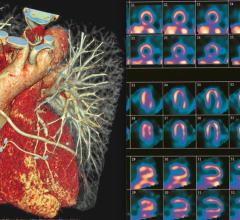
The FitnessSHIRT developed by Fraunhofer IIS measures the pulse, respiratory activity and exercise intensity. Image courtesy of Fraunhofer IIS/Kurt Fuchs
November 5, 2015 — The Fraunhofer Institute for Integrated Circuits IIS is introducing the FitnessSHIRT during the MEDICA trade fair. This smart apparel can continuously monitor various body signals in mobile application scenarios. The shirt can be worn during daily routine, is washable and features integrated sensors that measure the pulse and respiratory rate simultaneously.
Even the FitnessSHIRT does not work up sweat when exercising. The FitnessSHIRT is even more than just something you can easily slip on or wear under everyday clothes. “The integrated sensor technology means that for the first time, the pulse, respiratory activity and exertion level can be measured, analyzed and clearly displayed on an app,” explained Christian Hofmann, group manager of medical sensor Systems at Fraunhofer IIS.
Manufactured into the fabric of the T-shirt are special conductive materials that support easy and continuous monitoring of physiological signals without wires or cables. Textile electrodes capture the electrical activity of the heart muscle (EKG), but without constricting the body like a corset. An elastic measurement strap placed on the chest records the respiratory rate. The system also registers key statistics such as body posture, or the duration and intensity of the physical activity.
The technical heart of the FitnessSHIRT is a small housing for the sensor electronics that is attached to the shirt with a snap fastener and which also contains a fall detector and the power supply. After removing the housing, the T-shirt can be thrown into the washing machine. The combined analysis yields significant advantages, said Hofmann: “The raw data captured by the system – in other words the EKG – can be used to derive the heart rate, the heart rate variability (HRV) and the inhale and exhale duration in one single process.” The HRV is a more precise analysis of the EKG signals and allows a more in-depth analysis of how the heart rate adjusts and recovers after exertion. It also serves as a foundation for evaluating stress and relaxation states. The data is transmitted via wireless technology to a smartphone or smart watch. “Because it filters interference signals, the sensor module delivers precise and reliable performance statistics, even for active wearers in mobile environments.”
The FitnessSHIRT opens a wide range of application possibilities. It helps both amateur and top athletes carry out their training programs in a correct, efficient and optimal fashion and helps to avoid overexertion. It can also be used to keep rehab and high-risk patients from exceeding their physical activity limits.
The HeartBike, an intelligent Pedelec developed by HeartGo GmbH, receives the heart signal from the FitnessSHIRT worn by a cyclist and regulates the operation of the electric motor to provide a sufficient training incentive without overexerting the body. The system analyzes and documents the training progress and stores potentially critical events for later scrutiny. In nursing environments, conventional patient monitoring, and for stress and relaxation management programs, the intelligent wearable is well-suited for achieving positive health effects and providing the basis for a healthy lifestyle. Last but not least, it can help improve security for first responders working in hazardous situations by monitoring their vital functions.
Mainz-based ambiotex GmbH has already licensed the FitnessSHIRT and plans to introduce it to the market at the beginning of 2016.
For more information: www.iis.fraunhofer.de/en


 January 23, 2024
January 23, 2024 








